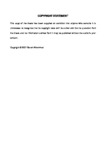Tracing Learning Environment in Java Programming Language
| dc.contributor.supervisor | Atkinson, Shirley | |
| dc.contributor.author | Alhammad, Sarah | |
| dc.contributor.other | School of Engineering, Computing and Mathematics | en_US |
| dc.date.accessioned | 2021-05-28T08:00:15Z | |
| dc.date.available | 2021-05-28T08:00:15Z | |
| dc.date.issued | 2021 | |
| dc.date.issued | 2021 | |
| dc.identifier | 10480182 | en_US |
| dc.identifier.uri | http://hdl.handle.net/10026.1/17208 | |
| dc.description.abstract |
The visualisation approach is one of the programming learning styles that has been taken into account in programming education. A collection of visualisation tools has emerged with the aim of assisting novice programmers in learning how to program. Each tool has its own set of features that may or may not be helpful in gaining a better understanding. The methods that we used in this study are focused on using memory referencing and visualisation to clarify what happens during individual program statement executions. Understanding the efficacy of current instructional resources is a critical component of gathering students' requirements and needs for future improvement. The “Tracing Learning Environment” (TLE) is developed for novice programmers to help them trace the sequence of execution of a software program and the reserved place of data in the memory. The framework relies on using visualisation as the programs are run and to show the effect of each statement in the code. It provides an environment for learners to see what happens to the data while running the program. The specification of the TLE draws largely on research regarding the role of visualisation in teaching computer programming and associated literature on tools to support learning programming. The TLE framework has been evaluated by conducting an empirical study using a mixed-method approach with novice and expert participants. The study has included surveys, focus groups, and semi-structured interviews. Student performance was measured before and after using the visualisation tool and compared with a control group who participated in a standard teaching session only. Early findings highlighted the need to visualise the control of the execution of code, evaluation of expressions, represent the class hierarchy along with the importance of a good interface/usability of the tool and to consider the programming languages supported. The evaluation findings are in line with the literature surrounding the benefits of using visualisation in learning to program. The findings found visualisation increased the students’ performance and confidence. When compared to the regular lab activities, the visualisation contributed to better understanding and support for learning to program. | en_US |
| dc.description.sponsorship | Ministry of Education, Saudi Arabia | en_US |
| dc.language.iso | en | |
| dc.publisher | University of Plymouth | |
| dc.subject | Programming learning | en_US |
| dc.subject | Visualisation | en_US |
| dc.subject.classification | PhD | en_US |
| dc.title | Tracing Learning Environment in Java Programming Language | en_US |
| dc.type | Thesis | |
| plymouth.version | publishable | en_US |
| dc.identifier.doi | http://dx.doi.org/10.24382/1061 | |
| dc.rights.embargoperiod | No embargo | en_US |
| dc.type.qualification | Doctorate | en_US |
| rioxxterms.version | NA |
Files in this item
This item appears in the following Collection(s)
-
01 Research Theses Main Collection
Research Theses Main


